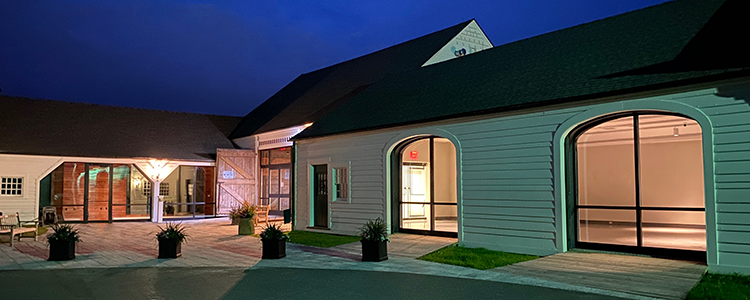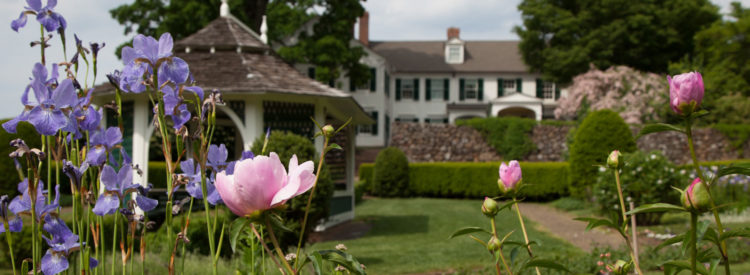Hill-Stead Museum Completes Its Carriage Barns Restoration!
Hill-Stead Museum executive director Dr. Anna Swinbourne announced at a June 22 ribbon-cutting ceremony, together with Governor Lamont, Bank of America, the State Historic Preservation Office (SHPO), and Hill-Stead’s Trustees & Board of Governors that the ambitious transformative renovation project to expand and elevate the institution has taken a major step forward with the completion of its Carriage Barns renovation and the public launch of Bringing Art to Life, its $6.9 million capital & endowment campaign.
“Hill-Stead has become a thriving home for arts, culture, and education, welcoming visitors from across the state and around the globe,” said Governor Ned Lamont. “Spurred by the need to address rotating exhibitions in conversation with its world-class collection, more than a million visitors since its opening in 1947 and an increasingly robust schedule of public programs, the building project will add significant capacity to serve diverse audiences.”

The announcement coincides with a lead gift of $500,000 from Bank of America—the largest corporate gift in the Museum’s history. “Bank of America believes in the power of the arts to help communities thrive, educate and enrich our society and create greater cultural understanding,” said Joe Gianni, President, Bank of America of Greater Hartford. “We are proud to be part of Hill-Stead’s growth into a nationally recognized epicenter for arts and educational initiatives, and this transformative gift underscores the institution’s key role in our community.”
Renowned architect Centerbrook Architects & Planners, a longtime partner in enhancing the Museum’s facility, steered the renovation. Project leads were Chad Floyd, principal; and Charles Mueller, senior director and principal of Centerbrook; Paul Campanelli, Joseph Sosnicki, and Carl Cote of PAC Group LLC. Construction began in September 2020 and culminated in June 2021 with a dramatic new presence for the Museum which maintains its historic footprint.
Total project costs were approximated at $4.3 million to fund the renovation of its existing spaces; an additional $2.6 million will expand its endowment and support operations, exhibitions and programming. To date, the campaign has raised more than $5.7 million through gifts received and pledges as it now moves into its public phase, chaired by Marie O’Brien.
“We are elated by the swift progress of the campaign and grateful for the tremendous generosity of our donors,” said Dr. Swinbourne. “With Connecticut Department of Economic and Community Development’s initial support of $1.75M along with Bank of America’s remarkable anchor gift, our public and private supporters have demonstrated their commitment to our vision for the future and the continued vitality of our beloved cultural hub. The state-of-the-art new space allows us to present compelling, rotating exhibitions and unique programming and to make Hill-Stead an even more vibrant center for meaningful learning experiences.”
Hill-Stead Museum received support for this project in part from the Historic Rehabilitation Tax Credit Program (CGS &10416c) administered by SHPO, an organization within the Department of Economic and Community Development. Eversource Energy was the purchaser of the state historic tax credits. Hill-Stead is deeply grateful for significant support from Caroline C. Edwards, Agnes Gund, Susan Gerbi McIlwain, Trumbull Family Foundation and William H. & Marianne Watson. Generous support has come from Hill-Stead’s Trustees & Board of Governors, as well as other philanthropic-minded families, corporate funders and foundations.
Decades of planning and incremental support from devoted donors underlie the project’s completion. Without altering its footprint, the historic Carriage Barns have now been transformed into an exhibition gallery and a new media space for topical and thought-provoking presentations. The renovation adds a 1,300 square-foot beautiful exhibition gallery, a new media space, a gorgeous terrace for public and private gatherings, a more welcoming public entrance and a thoughtfully-curated museum shop. The physical transformation will help preserve and empower Hill-Stead for generations to come with year-round exhibitions and public programming.
On the brink of its 75th anniversary, Hill-Stead Museum and its entire 152-acre campus received designation as a national historic landmark earlier this year. The Museum’s historic house has held this distinction since 1991. Hill-Stead was the first architectural project of founder Theodate Pope Riddle (1867–1946), one of the first licensed female architects in the U.S. and an early proponent of historic preservation. A love poem to her parents, the Colonial Revival mansion with its 152 acres of gardens and grounds and a treasure trove of Impressionist paintings by Manet, Monet, Degas, Whistler, and Cassatt has welcomed over a million visitors since opening to the public in 1947. Hill-Stead now unveils its new renovation project to ensure its extraordinary legacy.
